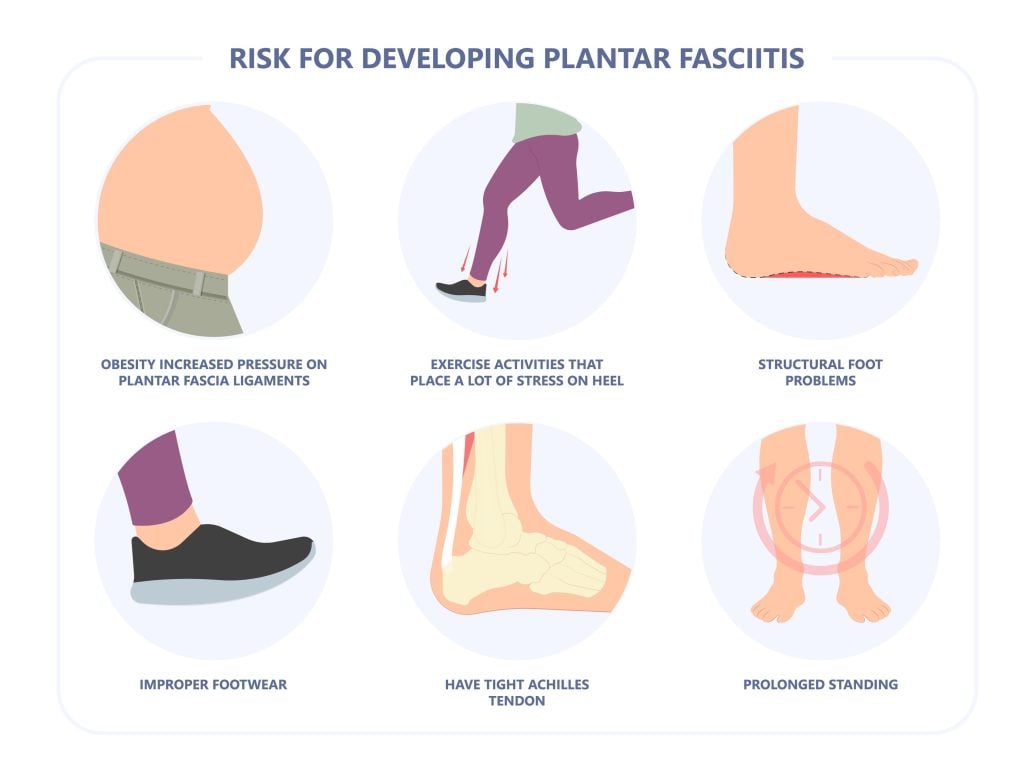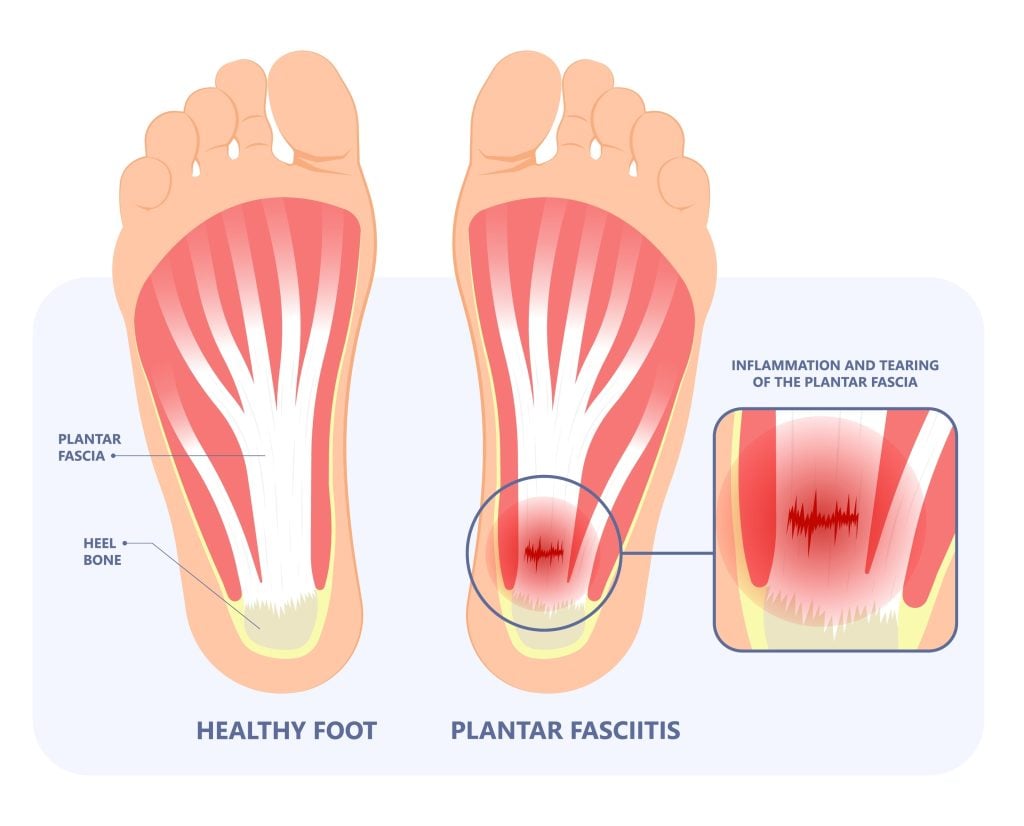Do You Struggle With Pain When Walking & Standing?
Test Out These Home Treatments For Fast Relief.
Have you ever woken up with a sharp pain in your heel or bottom of your foot? Chances are, you’ve had plantar fasciitis.
It’s a common issue, but you’re not stuck with it.
Plantar fasciitis and its accompanying heel pain are very common, but the good news is they are readily treatable. In fact, a lot of people have good success keeping their plantar fasciitis at bay with regular application of the exercises we are going to teach you about in this blog.
Simple exercises like calf stretches, towel curls, and even a tennis ball can ease discomfort and improve foot health.
But there’s plenty more than just these exercises – we cover off over 10 exercises and a slew of tips to keep your feet healthy and heel pain at bay.
Are you interested in learning what else you can do to combat and prevent this nagging pain that is impacting the quality of your life? Let’s get into it!
Understanding Plantar Fasciitis & Heel Pain
Let’s first explore plantar fasciitis and heel pain, a condition that affects millions and millions of people across the globe, leading to what can be debilitating discomfort in the heel and foot arch.
You might feel a sharp, stabbing pain in your heel, especially when you take your first steps in the morning or after standing for a long time. That’s plantar fasciitis.
It’s not just you. From runners to those carrying extra body weight, plantar fasciitis doesn’t discriminate.
So, what’s causing this pain? Overuse, strain, or injury to your plantar fascia – that’s the thick band of tissue connecting your heel to your toes.
But here’s the good news: You’re not powerless against this pain. Plantar fasciitis stretches and home therapy can provide relief. Simple foot stretching exercises and stretches for heel pain can loosen up that stubborn plantar fascia, reduce the stress on your foot, and help you regain your mobility.

From toe curls with a towel to tennis ball rolls, these exercises are your allies in this fight against heel pain. So, get ready to stretch your way to comfort. Remember, you’re not alone in this, and pain relief is possible.
Importance of Regular Plantar Fasciitis Home Therapies
While understanding plantar fasciitis is the first step, knowing the importance of regular stretches and exercises is equally significant in managing your heel pain.
Regular stretching helps to loosen the plantar fascia ligament, reducing stress and inflammation in the foot.
The great thing is that these stretches are simple and can be easily incorporated into your daily routine.
But it’s not just about stretching; vital exercises play a pivotal role, too. They can aid in pain relief and improve the overall function of your foot.
Consistent with these routines, you’ll notice an increase in your foot’s flexibility and a decrease in discomfort. You’ll be walking easier before you know it!

Easy Morning Stretches for Plantar Fasciitis Relief
Starting your day with some easy morning stretches can provide quick relief from plantar fasciitis pain. It’s like saying ‘good morning’ to your feet, and they’ll thank you for it!
These stretches help relieve stiffness, increase blood flow to the foot, and prevent your plantar fascia ligament from tightening overnight (click on the tabs below to learn more about each exercise):
First, try a gentle calf stretch. Stand facing a wall, place your hands on the wall, and step one foot back.
Keep your back leg straight and your heel on the floor, then lean into the wall.
You’ll feel a stretch in your calf and the bottom of your foot.
Please watch this video from Sharp HealthCare for two great calf stretch exercises you can do in the morning.
Then, grab a towel for some seated toe curls.
Place the towel on the floor and use your toes to scrunch it towards you.
This works your foot muscles and stretches your plantar fascia.
Here is a great video from Stone Clinic PT that explains the exercise clearly.
With your legs outstretched, sit on the floor with your feet together and loop the towel around your foot.
Gently pull back on the towel, stretching the bottom of your foot.
Here is a clear and easy video to follow from NHS Ayrshire & Arran – who doesn’t love a good scottish accent!
Incorporating these stretches into your morning routine can support your overall foot health. Remember, consistency is key! You’re part of a growing community that matters into its own hands and is taking steps to manage and alleviate heel pain, so keep it up!
Recommended Routine for Heel Pain
You’re not alone if you’re dealing with heel pain – over 50% of people experience plantar fasciitis or heel pain at some point in their lives, and there are several exercises you can do to help manage and alleviate the discomfort.
You can do more plantar fasciitis exercises throughout the day to keep your heel pain at bay. Remember – being regular and consistent with these exercises gives you the greatest chance of success:
An easy exercise is rolling stretches, where you place a round object under your foot and gently roll it back and forth.
This helps to massage and stretch your foot muscles.
If you can use a frozen bottle of water like the example in this video from NHS Ayrshire & Arran even better!
Seated foot stretches are also beneficial.
While sitting with one leg crossed, grab your toes and pull them towards your shin.
This simple stretch can relieve heel pain and tension in your foot.
Please watch this good example of a seated foot stretch from Ortholndy NorthWest.
Want to strengthen your foot muscles?
Try marble pickups.
These exercises can be done at your desk or while watching TV, making them a convenient addition to your routine.
Here is a good demonstration of the exercise for your understanding from Reddy Care Physical Therapy.
Advanced Stretches for Plantar Fasciitis (Towel Stretch, Calf Raises, etc)
After getting comfortable with basic heel pain exercises, it’s worth exploring some advanced stretches for plantar fasciitis that can further alleviate discomfort and improve foot strength.
With these more challenging moves, please take it to the next level, building on what you’ve already learned.
- Step Stretches: Use a step for a deeper plantar fascia stretch. Place your toes on the edge of a step, heels hanging off, and gently lower them for a nice deep stretch.
- Eccentric Calf Raises: These strengthen the calf muscles and improve foot stability. Stand on the edge of a step and slowly lower your heels, then raise them.
- Weighted Towel Stretches: Increase the effectiveness of towel stretches by adding resistance or weight. Pull a towel toward you with a weight on the other end.
- Balance Exercises: Enhance proprioception and foot strength with single-leg stands or wobbleboard exercises. Check out the great products from The Foot Collective if you want to excel in this important area of foot & ankle health.
How to Maintain Foot Health
Let’s explore how to maintain foot health and prevent conditions like plantar fasciitis.
Regular stretching is key. Making calf stretches and plantar fascia stretches a part of your daily routine can keep your feet flexible and pain-free. But don’t stop there.
Strengthening exercises, like toe curls and towel scrunches, can help fortify your feet against injuries.
The right footwear matters, too. Shoes with good arch support and cushioning can lessen the strain on your plantar fascia.
Consider swapping high-impact activities for low-impact ones to give your feet a break. Too much standing or walking can exacerbate heel pain, so moderation is your friend here.
Tips for Preventing Future Pain
Several easy steps can help prevent future plantar fasciitis pain. By following these tips, you’ll proactively care for your feet and reduce the risk of painful flare-ups.
Here are four key actions you can take:
- Invest in Supportive Footwear: Always wear shoes with good arch support. Your feet will thank you later.
- Ease into Physical Activity: Don't rush into intense workouts. Gradually increase your activity levels and regularly include stretches to keep your heels happy.
- Watch Your Weight: Maintain a healthy weight. Extra pounds can put added stress on your plantar fascia.
- Consider Orthotic Inserts: These can provide additional cushioning and support, helping to prevent heel pain. We sell & recommend Formthotics as a quality insole to help with plantar fasciitis.
And lastly, always listen to your body. Don’t ignore discomfort. Rest when required and address any foot discomfort promptly. You’re now part of a community that understands and supports your journey to prevent future pain. Together, we can keep plantar fasciitis at bay.
But if you need extra help, we strongly encourage you to contact an experienced heel pain Podiatrist.
We have many decades of combined experience and education in successfully dealing with plantar fasciitis and heel pain. So, if you have been trying all the above exercises without relief, we can help.
Summing It All Up...
So, don’t neglect those pesky foot pains. Remember, studies show that consistent stretching and exercise can reduce plantar fasciitis and heel pain by 52%.
Make calf stretches, tennis ball rolls, seated foot stretches, and towel curls part of your daily routine. With a bit of effort, you’ll not only kick the pain but also boost your foot health and flexibility.
Here’s to happier, healthier feet!
If you want the right professional advice on how to treat your heel pain, we currently have a limited offer running to help you out. For just $79 (usually valued at $189), book in online for our Complete Heel Pain Assessment & Treatment Consultation will get:
- Complete In-Depth Heel Pain Examination
- Review of Footwear & Personal Habit Diagnosis
- Treadmill Walking Gait Analysis & Video Assessment
- Complete Foot & Ankle Structural Diagnosis
- Effective Heel Pain Treatment Plan To Get You Walking Pain Free
- Peace of Mind You Know What Is Causing Your Heel Pain & How To Fix It
Ignoring heel pain or plantar fasciitis never cures it and your situation will likely get worse the longer you leave it.
Take control today by booking in online or call us today on (03) 4237 7165 to see one of our podiatrists and get this issue sorted once and for all.
Heel Pain & Plantar Fasciitis
Understand what causes your heel pain and what you can do to get rid of it once and for all. Find out what treatments can get you back to walking pain free so you can enjoy living an active life again!

